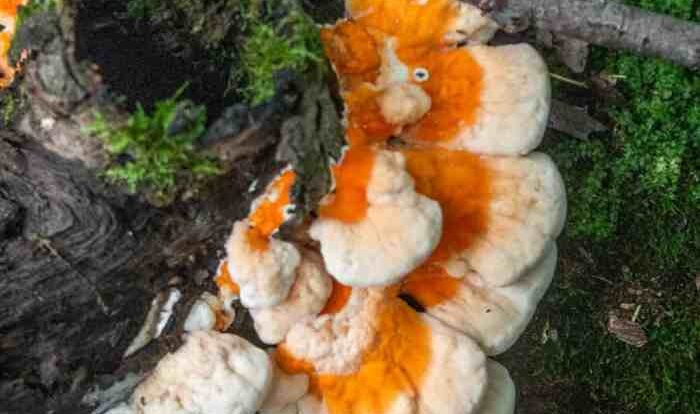
Embark on a culinary journey with the Chicken of the Woods recipe, where the vibrant flavors of this wild mushroom dance upon your palate, offering a delectable experience that will leave you craving for more.
From tantalizing soups and stews to vibrant salads and hearty pasta dishes, the versatility of Chicken of the Woods knows no bounds, promising a culinary adventure that will ignite your taste buds and leave you yearning for seconds.
Culinary Applications: Chicken Of The Woods Recipe

Chicken of the woods is a versatile mushroom with a meaty texture and a slightly sweet flavor. It can be used in a variety of dishes, from soups and stews to salads and pasta.
One of the most popular ways to cook chicken of the woods is to sauté it. To do this, simply heat some oil in a pan and add the mushrooms. Cook until they are browned and tender, about 5-7 minutes.
Sautéed chicken of the woods can be used as a side dish or added to other dishes, such as pasta or risotto.
Another popular way to cook chicken of the woods is to roast it. To do this, preheat your oven to 400 degrees Fahrenheit. Toss the mushrooms with some olive oil, salt, and pepper, and spread them on a baking sheet.
Roast for 20-25 minutes, or until they are browned and tender.
Chicken of the woods can also be used in soups and stews. To do this, simply add the mushrooms to the soup or stew pot along with the other ingredients. Cook until the mushrooms are tender, about 15-20 minutes.
Chicken of the woods is a delicious and versatile mushroom that can be used in a variety of dishes. Its meaty texture and slightly sweet flavor make it a great addition to soups, stews, salads, and pasta.
Salads
Chicken of the woods can be used in salads to add a meaty texture and a slightly sweet flavor. To do this, simply sauté the mushrooms until they are browned and tender, then add them to your salad. You can also add other ingredients to your salad, such as greens, vegetables, and cheese.
Here is a recipe for a simple chicken of the woods salad:
- 1 pound chicken of the woods mushrooms, sautéed
- 1 head of romaine lettuce, chopped
- 1/2 cup cherry tomatoes, halved
- 1/2 cup red onion, thinly sliced
- 1/4 cup crumbled feta cheese
- 1/4 cup olive oil
- 2 tablespoons red wine vinegar
- Salt and pepper to taste
To make the salad, simply combine all of the ingredients in a large bowl and toss to coat. Serve immediately.
Nutritional Value and Health Benefits
Chicken of the woods boasts an impressive nutritional profile, offering an array of essential nutrients that contribute to overall health and well-being.
It’s a rich source of protein, providing a substantial amount of essential amino acids that are crucial for building and repairing tissues. The mushroom is also high in fiber, which promotes digestive health and satiety. Additionally, it’s packed with vitamins, including vitamin D, which is vital for bone health, and vitamin C, a potent antioxidant that supports immune function.
Immune System Support
Chicken of the woods contains polysaccharides, complex carbohydrates that have been shown to possess immune-boosting properties. These compounds help stimulate the production of white blood cells, which play a key role in fighting off infections and maintaining overall health.
Antioxidant Properties
The mushroom is rich in antioxidants, which help protect cells from damage caused by free radicals. Free radicals are unstable molecules that can contribute to oxidative stress, a condition linked to chronic diseases such as heart disease and cancer. The antioxidants in chicken of the woods help neutralize these harmful molecules, reducing the risk of oxidative damage and promoting overall health.
Foraging and Identification

Embarking on a foraging adventure for chicken of the woods requires a keen eye and responsible practices. Identifying this delectable mushroom in its natural habitat involves discerning its unique characteristics and distinguishing it from potential lookalikes.
Identifying Chicken of the Woods, Chicken of the woods recipe
- Size and Shape:Chicken of the woods typically ranges from 4 to 12 inches in width, forming shelf-like structures with a wavy or lobed margin.
- Color:The upper surface boasts vibrant hues of orange to yellow, resembling the plumage of a chicken. The underside features white to cream-colored pores.
- Texture:The flesh is firm and meaty, with a slightly rubbery consistency when raw.
- Habitat:These mushrooms thrive on decaying oak, beech, and maple trees, often found at the base or on fallen logs.
Potential Lookalikes
Despite its distinct appearance, chicken of the woods can resemble certain lookalikes. To avoid confusion, consider these key differences:
- Laetiporus sulphureus (False Chicken of the Woods):This edible species is smaller and has a more orange-yellow coloration. Its pores are also larger and more widely spaced.
- Polyporus squamosus (Dryad’s Saddle):This non-edible mushroom has a grayish-brown cap and larger pores. It typically grows on the ground, not on trees.
- Aurantiporus fissilis (Orange Pore Fungus):This edible species has a brighter orange coloration and smaller pores. It is less common than chicken of the woods.
Responsible Foraging
While foraging for chicken of the woods can be an exciting experience, it is crucial to practice responsible harvesting. Here are some tips:
- Only harvest mature mushrooms with a firm texture.
- Leave some mushrooms behind for spore dispersal and future growth.
- Cut the mushrooms cleanly at the base, leaving the root system intact.
- Respect the environment and avoid damaging the trees or surrounding vegetation.
- Consider the mushroom’s conservation status and harvest sustainably.
Cultivation Techniques

Chicken of the woods can be cultivated at home, allowing you to enjoy its unique flavor and health benefits year-round. The process involves preparing a suitable substrate, inoculating it with mushroom spores or mycelium, and maintaining optimal growing conditions.
Substrate Preparation
The substrate provides nutrients and support for the mushroom mycelium. Ideal substrates for chicken of the woods include sawdust, wood chips, or logs. The substrate should be pasteurized to eliminate any contaminants that could hinder mushroom growth.
Inoculation
Once the substrate is prepared, it is inoculated with mushroom spores or mycelium. Spores can be purchased from reputable suppliers or collected from mature mushrooms. Mycelium is a vegetative part of the fungus that can be purchased in liquid or grain form.
Maintenance
After inoculation, the substrate is placed in a controlled environment that mimics the natural habitat of chicken of the woods. This includes providing adequate moisture, temperature, and airflow. The substrate should be kept moist but not waterlogged, and the temperature should be maintained between 55-65°F (13-18°C).
Challenges and Rewards
Mushroom cultivation can be a rewarding experience, but it also comes with challenges. Maintaining optimal growing conditions and preventing contamination can be difficult, especially for beginners. However, with patience and dedication, you can successfully cultivate chicken of the woods at home and enjoy the fruits of your labor.
Another great way to enjoy this versatile mushroom is in a chicken of the woods recipe that includes other vegetables. Sautéed with garlic, onions, and bell peppers, it becomes a hearty and flavorful side dish that will impress even the most discerning palates.
It’s also a great way to use up any leftover chicken of the woods you may have.
Creative Uses and Variations

Chicken of the woods is a versatile mushroom that can be incorporated into a wide range of culinary creations. Its meaty texture and savory flavor make it an excellent substitute for chicken in many dishes.
Beyond its use as a meat alternative, chicken of the woods can also be used to create unique flavor combinations. Its earthy, slightly sweet flavor pairs well with a variety of ingredients, including herbs, spices, and vegetables.
Sauces and Marinades
Chicken of the woods can be used to create flavorful sauces and marinades. Its natural umami can enhance the taste of grilled meats, vegetables, and tofu.
If you’re looking for a delicious and unique culinary experience, you have to try the chicken of the woods recipe . This edible fungus has a meaty texture and a savory flavor that makes it a perfect substitute for chicken in many dishes.
You can find it growing on the trunks of dead trees in forests throughout the world.
- Creamy Mushroom Sauce:Sauté chicken of the woods with garlic and onions. Add cream, vegetable broth, and herbs to create a rich and flavorful sauce.
- BBQ Marinade:Combine chicken of the woods, olive oil, vinegar, brown sugar, and spices to create a tangy and savory marinade for grilling.
Other Culinary Applications
In addition to sauces and marinades, chicken of the woods can be used in a variety of other culinary applications:
- Soups and Stews:Add chicken of the woods to soups and stews for a boost of flavor and nutrition.
- Stir-fries:Sauté chicken of the woods with vegetables and sauce for a quick and easy stir-fry.
- Pizza Toppings:Use chicken of the woods as a topping for pizza, along with other vegetables and cheese.
- Burgers:Grind chicken of the woods and combine it with ground beef or turkey to create flavorful and healthy burgers.
Final Review
As we bid farewell to this delectable exploration, let the memory of Chicken of the Woods linger on your taste buds, inspiring you to create culinary masterpieces that will delight your family and friends.
Whether you’re a seasoned chef or a novice in the kitchen, the Chicken of the Woods recipe empowers you to unlock a world of culinary possibilities, transforming ordinary meals into extraordinary feasts.
FAQ Guide
What are the health benefits of Chicken of the Woods?
Chicken of the Woods is a nutritional powerhouse, boasting high levels of protein, fiber, and vitamins. It’s also a good source of antioxidants, which can help protect your body from damage caused by free radicals.
How can I identify Chicken of the Woods in the wild?
Chicken of the Woods has a distinctive appearance, with bright orange or yellow shelves that resemble chicken feathers. It typically grows on dead or dying hardwood trees, especially oak.
Can I cultivate Chicken of the Woods at home?
Yes, it is possible to cultivate Chicken of the Woods at home. However, it requires specialized knowledge and equipment. If you’re interested in trying, there are many resources available online to guide you through the process.




